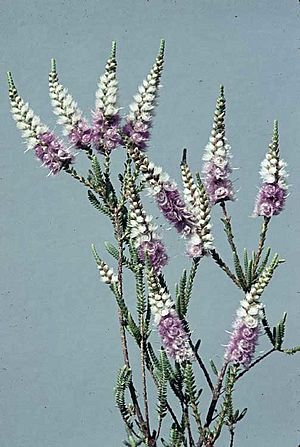Spiked featherflower facts for kids
Quick facts for kids Spiked featherflower |
|
|---|---|
 |
|
| Verticordia spicata subsp. spicata | |
| Scientific classification | |
| Genus: |
Verticordia
|
| Species: |
spicata
|
The Spiked Featherflower, also known as Verticordia spicata, is a beautiful flowering plant. It belongs to the myrtle family, called Myrtaceae. This plant grows only in the south-west part of Western Australia. It is a bushy shrub that can be quite dense. It has small leaves that hug its stems. You can see its lovely pink flowers in spikes from late spring to early summer.
What it Looks Like
The Spiked Featherflower is a shrub that stands upright or spreads out. It usually grows about 0.3 to 1 meter (about 1 to 3 feet) tall. Sometimes, it can even reach 2 meters (about 6.5 feet) in height. It often has one main stem at its base.
Its leaves are packed closely together along the branches. Most of them hug the stem tightly. These leaves are shaped like wide eggs and are about 1.5 to 3.5 millimeters (about 0.06 to 0.14 inches) long. They have tiny oil glands that you can see. The edges of the leaves are thin, see-through, and a bit hairy.
The flowers have a nice smell. They grow in spike-like groups on the upper parts of the plant's branches. Each flower sits on a very short stalk, less than 0.2 millimeters (about 0.008 inches) long. The part of the flower that holds the petals and sepals, called the floral cup, is shaped like a top. It is about 2 millimeters (about 0.08 inches) long and smooth. It also has two green parts that stick out, each about 1.9 millimeters (about 0.07 inches) long.
The sepals, which are like small leaves that protect the flower bud, are pale pink to light purple. They spread out and are about 3 to 5.5 millimeters (about 0.12 to 0.22 inches) long. They have 6 or 7 feathery parts and two ear-like parts on their sides. The petals are similar in color to the sepals. They are about 3 to 4.5 millimeters (about 0.12 to 0.18 inches) long and stand upright. They have long, thin parts at their ends. The style, which is part of the female reproductive organ of the flower, is about 4 to 7 millimeters (about 0.16 to 0.28 inches) long. It is curved and a little hairy near its tip. This plant blooms from October to January.
How it was Named
The Spiked Featherflower was first officially described in 1859. A scientist named Ferdinand von Mueller wrote about it. He found a sample of the plant near the Murchison River. Mueller published his description in a book called Fragmenta phytographiae Australiae.
The second part of its scientific name, spicata, comes from a Latin word, spica. This word means "spike," which describes how the flowers grow.
Later, in 1991, another scientist named Alex George looked closely at the group of plants called Verticordia. He placed the Spiked Featherflower into a smaller group called Verticordella.
There are also two types, or subspecies, of the Spiked Featherflower:
- Verticordia spicata subsp. spicata: This type has a style (part of the flower) that is about 6.5 to 9 millimeters (about 0.26 to 0.35 inches) long. Its leaves are usually longer than 2 millimeters (about 0.08 inches).
- Verticordia spicata subsp. squamosa: This type is also known as the scaly-leaved featherflower. It has a style that is about 4 millimeters (about 0.16 inches) long. Its leaves are shorter than 2 millimeters (about 0.08 inches).
Where it Grows
The Spiked Featherflower grows in several areas of Western Australia. You can find it between the Cooloomia Nature Reserve, near the Murchison River, and places like Kalbarri National Park, Northampton, and Mullewa. These areas are part of different natural regions, including the Avon Wheatbelt and the Geraldton Sandplains.
The scaly-leaved featherflower (subspecies squamosa) is found only in the eastern part of this area. It grows between Three Springs and Morawa. Both types of Spiked Featherflower like to grow in sandy soil. This soil is often found over granite or sandstone rocks. They live in areas with heath plants or shrublands.
Conservation Status
The Western Australian Government's Department of Parks and Wildlife says that Verticordia spicata subsp. spicata is "not threatened." This means it is not currently in danger of disappearing.
However, the subspecies squamosa is classified as "Threatened Flora". This means it is considered "Endangered" (EN) under the Australian Government's Environment Protection and Biodiversity Conservation Act 1999 (EPBC Act). Because it is endangered, a special plan has been made to help it recover. This plan is called an Interim Recovery Plan.
Growing this Plant
It can be tricky to grow both types of Spiked Featherflower, especially the squamosa subspecies. The spicata subspecies has been grown from cuttings (pieces of the plant), from seeds, and by grafting. Grafting means joining a part of this plant onto the root system of another plant, like the Darwinia citriodora.
When these plants grow to full size, they look very pretty. Some of them have even lived for up to 14 years in gardens.

